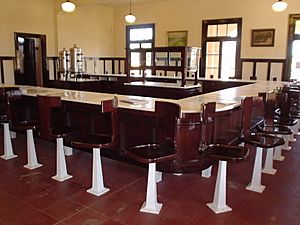Kelso Depot facts for kids
|
Kelso Depot, Restaurant and Employees Hotel
|
|
 |
|
| Location | 90942 Kelso Cima Road Kelso, California |
|---|---|
| Built | 1923 |
| Architect | Los Angeles and Salt Lake R.R. |
| Architectural style | Mission Revival & Spanish Colonial Revival architecture |
| NRHP reference No. | 01000760 (original) 100003401 (increase 1) 100011934 (increase 2) |
Quick facts for kids Significant dates |
|
| Added to NRHP | August 2, 2001 |
| Boundary increases | January 31, 2019 June 17, 2025 |
The Kelso Depot, Restaurant and Employees Hotel, often called Kelso Depot, is a historic building in the Mojave Desert. It is located inside the Mojave National Preserve in Kelso, California. Today, it serves as the main Mojave National Preserve Visitors Center.
This special building was added to the National Register of Historic Places in 2001. The area around it, including the nearby ghost town of Kelso, became a United States Historic District in 2000. Its historic area was made larger in 2019 and again in June 2025.
Contents
A Look Back: Kelso Depot's Story
Building a Desert Oasis
The first train station in Kelso was built in 1905 by the Los Angeles and Salt Lake Railroad. But in 1923, they started building a much bigger and fancier place. This new building, called the "Kelso Clubhouse & Restaurant," opened in 1924.
The Kelso Depot was built to help train passengers and railroad workers. It also provided a crucial water stop for the big steam locomotives. These engines needed a lot of water to run across the desert.
The depot is a great example of Mission Revival and Spanish Colonial Revival architecture. It had a hotel, a restaurant, and even pretty gardens. It was designed by the famous firm of John and Donald Parkinson.
This station was very important for moving people and goods across the country. It also helped transport ore from local mines, like the Vulcan Mine. The Union Pacific Railroad wanted to make its stations modern and attractive. They wanted to compete with other railroads, like the Santa Fe Railway and its famous Harvey Houses.
The depot's beautiful design and gardens made it a popular spot. It was a gathering place for railroad employees, travelers, and people living nearby. While many of the original gardens are gone, some date palm trees still stand today.
Changes Through the Years
The Kelso Depot played a big role during World War II. It helped the Union Pacific Railroad move soldiers and supplies for the war effort.
After the war, things started to change. Fewer people traveled by train, and new diesel engines replaced steam engines. Diesel engines didn't need water stops or as many workers. This meant the depot was not as busy. The Vulcan Mine also closed in 1947, which further reduced train traffic.
There was a brief increase in activity during the Korean War in the early 1950s. But by the 1960s, even more powerful diesel engines arrived. These new engines meant that "helper locomotives" were no longer needed to push trains up steep hills.
On August 14, 1964, passenger train service to Kelso stopped completely. The station agency also closed. The depot's main purpose was over, though its Lunch Room stayed open until 1985.
Saving the Depot: A New Beginning
By 1985, the Union Pacific Railroad wanted to tear down the unused depot. But many people wanted to save this historic building. Their efforts worked, and in 1992, the depot was given to the Bureau of Land Management.
In 1994, the Mojave National Preserve was created. The depot then became part of the National Park Service. A big project began in 2002 to restore the building to its former glory.
Since 2005, the Kelso Depot has been the main Visitor Center for the Mojave National Preserve. It's a place where people can learn about the desert and its history.
See also




